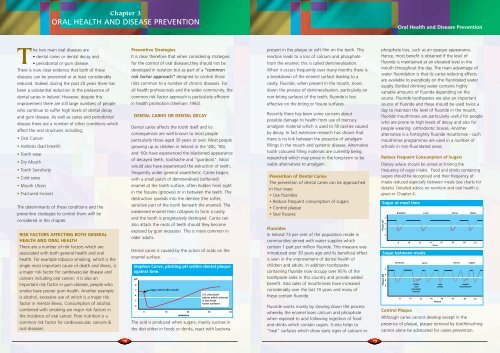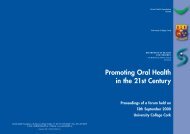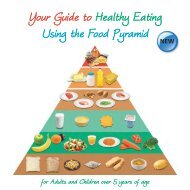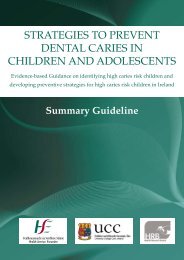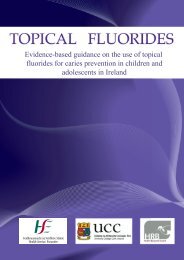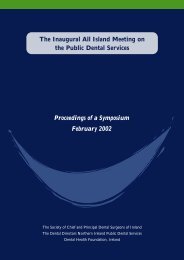Oral Health - Dental Health Foundation
Oral Health - Dental Health Foundation
Oral Health - Dental Health Foundation
Create successful ePaper yourself
Turn your PDF publications into a flip-book with our unique Google optimized e-Paper software.
Chapter 3<br />
ORAL HEALTH AND DISEASE PREVENTION<br />
<strong>Oral</strong> <strong>Health</strong> and Disease Prevention<br />
The two main oral diseases are<br />
• dental caries or dental decay and<br />
• periodontal or gum disease.<br />
There is now clear evidence that both of these<br />
diseases can be prevented or at least considerably<br />
reduced. Indeed, during the past 20 years there has<br />
been a substantial reduction in the prelavence of<br />
dental caries in Ireland. However, despite this<br />
improvement there are still large numbers of people<br />
who continue to suffer high levels of dental decay<br />
and gum disease. As well as caries and periodontal<br />
disease there are a number of other conditions which<br />
affect the oral structures including;<br />
• <strong>Oral</strong> Cancer<br />
• Halitosis (bad breath)<br />
• Tooth wear<br />
• Dry Mouth<br />
• Tooth Sensitivity<br />
• Cold sores<br />
• Mouth Ulcers<br />
• Fractured Incisors<br />
The determinants of these conditions and the<br />
preventive strategies to control them willl be<br />
considered in this chapter.<br />
RISK FACTORS AFFECTING BOTH GENERAL<br />
HEALTH AND ORAL HEALTH<br />
There are a number of risk factors which are<br />
associated with both general health and oral<br />
health. For example tobacco smoking, which is the<br />
single most important cause of death and illness, is<br />
a major risk factor for cardiovascular disease and<br />
cancers including oral cancer; it is also an<br />
important risk factor in gum disease, people who<br />
smoke have poorer gum health. Another example<br />
is alcohol, excessive use of which is a major risk<br />
factor in mental illness. Consumption of alcohol,<br />
combined with smoking are major risk factors in<br />
the incidence of oral cancer. Poor nutrition is a<br />
common risk factor for cardiovascular, cancers &<br />
oral diseases.<br />
Preventive Strategies<br />
It is clear therefore that when considering strategies<br />
for the control of oral diseases,they should not be<br />
developed in isolation but as part of a “common<br />
risk factor approach” designed to control those<br />
risks common to a number of chronic diseases. For<br />
all health professionals and the wider community, the<br />
common risk factor approach is particularly efficient<br />
in health promotion (Sheiham 1992).<br />
DENTAL CARIES OR DENTAL DECAY<br />
<strong>Dental</strong> caries affects the tooth itself and its<br />
consequences are well known to most people<br />
particularly those aged 30 years or over. Most people<br />
growing up as children in Ireland in the ‘40s, ‘50s<br />
and ‘60s have experienced the blackened appearance<br />
of decayed teeth, toothache and “gumboils”. Most<br />
would also have experienced the extraction of teeth,<br />
frequently under general anaesthetic. Caries begins<br />
with a small patch of demineralised (softened)<br />
enamel at the tooth surface, often hidden from sight<br />
in the fissures (grooves) or in between the teeth. The<br />
destruction spreads into the dentine (the softer,<br />
sensitive part of the tooth beneath the enamel). The<br />
weakened enamel then collapses to form a cavity<br />
and the tooth is progressively destroyed. Caries can<br />
also attack the roots of teeth should they become<br />
exposed by gum recession. This is more common in<br />
older adults.<br />
<strong>Dental</strong> caries is caused by the action of acids on the<br />
enamel surface.<br />
Stephan Curve, plotting pH within dental plaque<br />
against time.<br />
pH<br />
8<br />
7<br />
6<br />
5<br />
4<br />
sugar enters the mouth<br />
5.5 critical pH<br />
below which mineral<br />
is lost from<br />
tooth surfaces<br />
0 10 20 30 40<br />
minutes<br />
The acid is produced when sugars, mainly sucrose in<br />
the diet either in foods or drinks, react with bacteria<br />
present in the plaque or soft film on the teeth. This<br />
reaction leads to a loss of calcium and phosphate<br />
from the enamel; this is called demineralisation.<br />
When it occurs frequently over many months there is<br />
a breakdown of the enamel surface leading to a<br />
cavity. Fluoride, when present in the mouth, slows<br />
down the process of demineralisation, particularly on<br />
non-biting surfaces of the teeth; fluoride is less<br />
effective on the biting or fissure surfaces.<br />
Recently there has been some concern about<br />
possible damage to health from use of mercury<br />
amalgam material which is used to fill cavities caused<br />
by decay. In fact extensive research has shown that<br />
there is no link between the presence of amalgam<br />
fillings in the mouth and systemic disease. Alternative<br />
tooth coloured filling materials are currently being<br />
researched which may prove in the long-term to be<br />
viable alternatives to amalgam.<br />
Prevention of <strong>Dental</strong> Caries<br />
The prevention of dental caries can be approached<br />
in four ways<br />
• Use fluorides<br />
• Reduce frequent consumption of sugars<br />
• Control plaque<br />
• Seal fissures<br />
Fluorides<br />
In Ireland 73 per cent of the population reside in<br />
communities served with water supplies which<br />
contain 1 part per million fluoride. This measure was<br />
introduced over 30 years ago and its beneficial effect<br />
is seen in the improvement of dental health of<br />
children and adults. In addition toothpastes<br />
containing fluoride now occupy over 95% of the<br />
toothpaste sales in this country and provide added<br />
benefit. Also sales of mouthrinses have increased<br />
considerably over the last 10 years and many of<br />
these contain fluoride.<br />
Fluoride works mainly by slowing down the process<br />
whereby the enamel loses calcium and phosphate<br />
when exposed to acid following ingestion of food<br />
and drinks which contain sugars. It also helps to<br />
“heal” surfaces which show early signs of calcium or<br />
phosphate loss, such as an opaque appearance.<br />
Hence, most benefit is obtained if the level of<br />
fluoride is maintained at an elevated level in the<br />
mouth throughout the day. The main advantage of<br />
water fluoridation is that its caries reducing effects<br />
are available to everybody on the fluoridated water<br />
supply. Bottled drinking water contains highly<br />
variable amounts of fluoride depending on the<br />
source. Fluoride toothpastes are also an important<br />
source of fluoride and these should be used twice a<br />
day to maintain the level of fluoride in the mouth;<br />
fluoride mouthrinses are particularly useful for people<br />
who are prone to high levels of decay and also for<br />
people wearing orthodontic braces. Another<br />
alternative is a fortnightly fluoride mouthrinse - such<br />
mouthrinse programmes are used in a number of<br />
schools in non-fluoridated areas.<br />
Reduce Frequent Consumption of Sugars<br />
Dietary advice should be aimed at limiting the<br />
frequency of sugar intake. Food and drinks containing<br />
sugars should be recognised and their frequency of<br />
intake reduced especially between meals (see charts for<br />
details). Detailed advice on nutrition and oral health is<br />
given in Chapter 4.<br />
Sugar at meal time<br />
Plaque pH<br />
Plaque pH<br />
7<br />
6<br />
5<br />
4<br />
Breakfast<br />
• •<br />
••• •<br />
•<br />
•<br />
••• • • •••••<br />
8<br />
•<br />
10<br />
12<br />
Sugar between meals<br />
7<br />
6<br />
5<br />
4<br />
• ••••••••••<br />
• •<br />
•<br />
•<br />
•<br />
•<br />
•<br />
•<br />
•<br />
•<br />
• •••••••••<br />
•<br />
•<br />
•<br />
•<br />
• ••<br />
• •<br />
•<br />
•<br />
•<br />
•<br />
Lunch Dinner Supper<br />
•<br />
•<br />
• • • •<br />
• • •<br />
• ••••••••<br />
14<br />
Hours<br />
•<br />
•<br />
•<br />
•<br />
•<br />
•<br />
•<br />
•<br />
•<br />
• ••<br />
• ••• • ••••••••• • •••••••• • •••••••••<br />
Breakfast Lunch Dinner Supper<br />
Coffee<br />
and<br />
chocolate<br />
biscuits<br />
Control Plaque<br />
Although caries cannot develop except in the<br />
presence of plaque, plaque removal by toothbrushing<br />
cannot alone be advocated for caries prevention.<br />
16<br />
• •<br />
• • •<br />
• • •<br />
• • •• •<br />
•<br />
• •<br />
cola<br />
drinks<br />
•<br />
18<br />
•<br />
•<br />
• • •<br />
•<br />
••<br />
• ••••<br />
•<br />
•<br />
•<br />
•<br />
•<br />
• ••••••••<br />
20<br />
sweets<br />
watching TV<br />
22<br />
• • •<br />
• •••• • ••••••••••• • ••••••<br />
• •<br />
8 10 12 14 16 18 20 22<br />
Hours<br />
12<br />
13


